





Backbone osteochondrosis
General characteristic of a disease
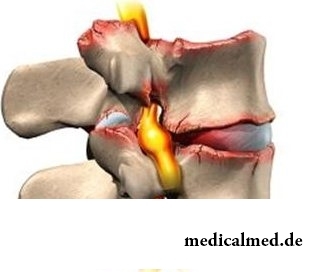
Osteochondrosis of a backbone is the disease caused by destruction of bone and cartilaginous fabrics of cervical, chest and lumbar departments of a backbone.
First of all when progressing a disease the central part of a vertebral disk – a so-called jellylike kernel changes. Because of it the vertebra loses a part of the shock-absorbing properties, and on a fibrous ring on the periphery of a disk thinning and cracks is formed.
Further progressing of osteochondrosis of a backbone leads to disease complications – protrusion of disks or ruptures of a fibrous ring and intervertebral hernia as to its investigation. Instability of a backbone in an affected area leads to pain and limited mobility of the head at osteochondrosis of a backbone of cervical department, and also to limited mobility of a trunk at osteochondrosis of chest department of a backbone and lumbar.
In 75% of cases osteochondrosis of a backbone is the reason of a dorsodynia. With age the risk of dystrophy of tissues of backbone significantly increases therefore on average symptoms of osteochondrosis of a backbone are observed at every second inhabitant of the planet 30 years are more senior.
Backbone osteochondrosis reasons
In development of osteochondrosis of a backbone injuries of a back or systematic loads of a back are considered as provocative factors at hard physical activity or professional employment in the conditions of vibration. If you have to be engaged much in handling works, get a hydroboard for the car.
Early manifestation of symptoms of osteochondrosis of a backbone is caused by poor physical development, flat-footedness or excess weight. There is also genetic predisposition to a loose structure of intervertebral disks and anomalies of a structure of a backbone. In respect of health of a backbone also intensive trainings in the gym with violation of the rules of distribution of load of a back, a sedentary life and improper feeding are adverse.
Backbone osteochondrosis symptoms
The disease is shown by a number of typical symptoms. Are characteristic of osteochondrosis of a backbone: the aching dorsodynia, feeling of numbness in the struck department of a backbone, reduction of amplitude of movements, strengthening of pain at rise in weight, the sharp movement, tension during cough or sneezing.
Chronic pain as one of backbone osteochondrosis symptoms, becomes the reason of increased fatigue. When squeezing nervous roots backbone disks pain can be more intensive and have the sharp, "shooting" character. Its localization in this case are not limited to area of a back, and it is felt as the person around extremities.
Backbone osteochondrosis stages
The disease stage depends on expressiveness of symptoms of osteochondrosis of a backbone. At the first stage of osteochondrosis of a backbone pain is practically not felt if only an easy indisposition and weak resistance of a backbone to injuries. Destruction of a fibrous ring, reduction of the sizes of vertebral cracks and pain of various intensity – a symptom of osteochondrosis of a backbone of the second stage.
The third stage of a disease is characterized by essential deformations of bone and vertebral fabrics up to emergence of hernias nuclei pulposi. A symptom of osteochondrosis of a backbone of the heaviest fourth stage are mass bone growths, limited mobility, a megalgia, and also the full or partial paralysis of extremities caused by a prelum of nervous roots.
Symptoms of osteochondrosis of cervical department of a backbone
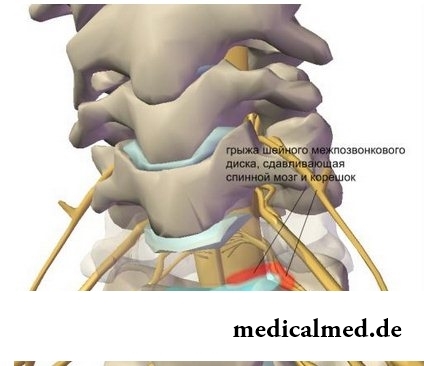
Osteochondrosis of cervical department of a backbone quite often leads to disturbances of blood circulation because of squeezing of arteries. It leads to an intensive headache, dizzinesses and faints. At osteochondrosis of cervical department of a backbone the syndrome of a vertebral artery is sometimes observed. It is characterized by feeling of noise in the head, flashing of "front sights" or color spots before eyes. At osteochondrosis of cervical department of a backbone also peripheral pains in shoulders or hands are possible.
Symptoms of osteochondrosis of chest department of a backbone
Osteochondrosis of chest department of a backbone can aggravate the course of various cardiac pathologies. The disease causes progressing of intercostal neuralgia (squeezing of intercostal nerves). At osteochondrosis of chest department of a backbone the stethalgia and feeling of "stake" in the center of a thorax are observed.
Symptoms of osteochondrosis of lumbar department of a backbone
Osteochondrosis of lumbar department of a backbone leads to development of the following diseases: to a sciatica, lumbago and so-called lumbar radiculitis.
The sciatica as one of complications of osteochondrosis of lumbar department of a backbone, is characterized by defeat of a sciatic nerve, pain in a rump, the hypotonia (lowered by a tone) sural and gluteuses.
At a lumbago the sharp lower back pain caused by the shift of vertebrae or loss of a vertebral disk acts as a symptom of osteochondrosis of lumbar department of a backbone.
Lumbar radiculitis, one more complication of osteochondrosis of lumbar department of a backbone, is provoked by hernias of the lowermost disks of a backbone. It is followed by buttock pain with irradiation in the back surface of a hip, a popliteal space, a shin and foot.
Diagnosis of osteochondrosis of a backbone
The preliminary diagnosis "backbone osteochondrosis" is established by the neurologist after primary survey in connection with complaints of the patient to a dorsodynia and limited mobility. The stage of osteochondrosis of a backbone is stated depending on extent of deformation of a backbone, a condition of a bearing of the patient and quantity of the struck disks.
All above-stated symptoms of osteochondrosis of a backbone are diagnosed by means of palpation of a back of the patient. The doctor also pays attention to a condition of a muscle tone. As in most cases the disease is followed by a hyper tone of muscles of a back.
By tests for bending of a backbone amplitude of movements of the patient is defined. Thanks to a X-ray analysis, the diagnosis is concretized by KT and MPT and future tactics of treatment of osteochondrosis of a backbone is defined.
Treatment of osteochondrosis of a backbone
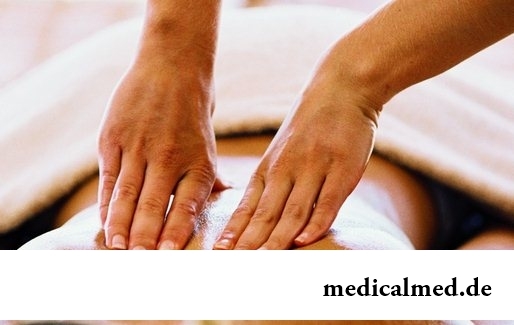
In treatment of osteochondrosis of a backbone conservative and surgical techniques are applied. The purpose they are to eliminate a pain syndrome and to prevent further progressing of deformation of a backbone.
At the same time surgical treatment of osteochondrosis of a backbone is applied only if conservative therapy of a disease was inefficient.
The active stage of use of conservative methods lasts on average 2 months. At the beginning of its perhaps short-term strengthening of a pain syndrome caused by reaction of an organism to medicines, physiotherapy exercises (LFK) and physical therapy. In conservative treatment of osteochondrosis of a backbone also massage, manual therapy, an extract and reflexotherapy are applied. Efficiency of treatment of osteochondrosis of a backbone depends on systemacity of procedures and persistence of the most sick in performance of the LFK complexes.
Surgical treatment of osteochondrosis of a backbone is carried out at hernia of intervertebral disks whose prescription exceeds 6 months. The indication to carrying out operation is also reduction of a crack between vertebrae to 1/3 initial sizes and a prelum of roots of a spinal cord.
The leading method in surgical treatment of osteochondrosis of a backbone - a diskektomiya, i.e. removal of the deformed disk. Operation can be the low-invasive, carried-out by means of endoscopic tools by method mikrodiskektomiya, B-Twin of system, and also puncture laser vaporization of a kernel of the deformed disk.
After surgical treatment of osteochondrosis of a backbone the rehabilitation period within 6 months is supposed. During it the patient goes for sanatorium treatment for passing of a course of physical therapy, manual therapy, acupuncture, etc.
To tell even the shortest and simple words, we involve 72 muscles.

What is in our understanding weeds? It plants which are considered to be suitable only for compost pits and feeding жи...
Section: Articles about health
Popular joke that there are no healthy people, and is nedoobsledovanny, most of us considers an honest truth, continually it is necessary to hear that all of us are sick hardly from a school bench. It is hard to say, whether so it actually because...
Section: Articles about health
The fatigue, sleep debt, disturbances of food, bad mood, vagaries of the weather – all these circumstances badly affect our appearance. Especially the person suffers: skin becomes flabby, loses healthy color, becomes covered by wrinkles, zones of hypostases and dark circles under eyes appear. It is not always possible to be saved from influence of aggressive factors, but we are quite able to minimize its effects. For this purpose usually apply the cosmetics and procedures helping увлаж...
Section: Articles about health
The summer of this year in Russia was very ambiguous. Regions suffered from a merciless heat, from pouring rains, from times...
Section: Articles about health
The popular expression "run from a heart attack" became the motto of the people supporting active lifestyle. Moreover, run became a peculiar fashionable tendency: sales of racetracks and the accompanying goods for run are at permanently high level. Really...
Section: Articles about health
Dogrose – one of the most widespread adornment and medicinal plants growing practically in all territory of our country. To most of Russians it is a beautiful bush it is known, first of all, as a source of fruits, extremely vitamin-rich. However curative properties of a dogrose are not limited to it at all. About how still it is possible to use a plant in the medical purposes, we will tell today....
Section: Articles about health
Wood louse – the ordinary-looking unpretentious plant extended in all territory of our country. It quickly expands, and sometimes for...
Section: Articles about health
The Genetically Modified Organisms (GMO) are plants or animals (as a rule, agricultural) to whose genotype purposeful changes were made. Opposition of supporters and opponents of inclusion of such organisms in foodstuff всег...
Section: Articles about health
Condition of lips (their morbidity, outward) – one of indicators of health of the person. The peeling, dryness, pallor, and also cracks in corners of a mouth can be not only the cosmetic shortcoming which arose owing to physical damages and weather conditions but also the satellite of some diseases and disturbances in an organism needing treatment. Let's consider 10 possible reasons of emergence of angular cracks (perleches) in corners of a mouth and ways of their elimination....
Section: Articles about health
Household skills which to us so diligently imparted in the childhood it appears, not always bring only benefit. According to result...
Section: Articles about health
Extracorporal fertilization – one of the most modern methods of controlling with infertility. So far he already helped a significant amount of married couples to become happy parents. Usually to the EKO procedure difficult and very expensive, resort in those...
Section: Articles about health
Water with a lemon - idle time in preparation drink which supporters of a healthy lifestyle already managed to appreciate. Used in a warm look and on an empty stomach, it is one of the most useful prophylactics allowing to prevent tens of diseases and just to raise an organism tone. Especially effectively to use warm water with lemon juice after a serious illness, during a season of the colds, and also to children, old men and pregnant women which do not have contraindications...
Section: Articles about health
The kid who was recently born is surrounded with love of adult family members and their cares without which the baby cannot exist....
Section: Articles about health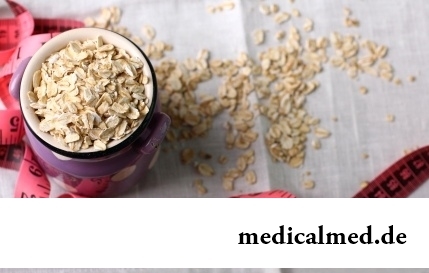
The list of stereotypes of which, apparently, all know strongly includes following: British surely eat porridge for breakfast. Perhaps, not all modern residents of Britain arrive quite so, but for those from them which continue to follow this t...
Section: Articles about health
Cold – a state known to everyone which is followed by cold, cough, high temperature, a pharyngalgia. Often the first that we begin to do in hope again to become healthy – to accept medicines which are not always harmless whereas it is easy to facilitate displays of a disease by means of natural means. They not only softly eliminate disease symptoms, but also enrich the weakened organism with useful substances. We present you 8 drinks which are successfully used for...
Section: Articles about health
Partial and the more so full loss of hearing significantly reduces quality of life. Difficulties with communication lead to loneliness and замкн...
Section: Articles about health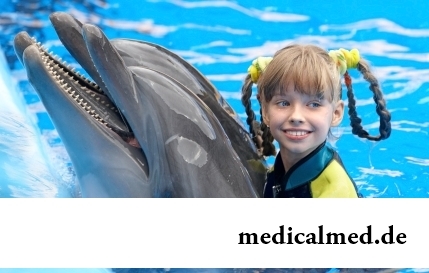
On health of the person physicians know about salutary action of animals long ago. About 7 thousand years ago great Hippocrates recommended to the patients riding walks for strengthening of a nervous system and increase in vitality....
Section: Articles about health
The main role in development of a peptic ulcer of a stomach and duodenum the bacterium Helikobakter plays pilor. Activity and the strengthened reproduction of this microorganism lead to weakening of protection of mucous membranes and their erosive damage. Displays of an illness seriously reduce quality of life: patients regularly test attacks of severe pain, heartburn, nausea. On this background also psychoemotional malfunctions develop: a kidney-vetch, as a rule, shows an acrimony, ча...
Section: Articles about health
Dietary supplements (dietary supplements) for the last decades were so thoroughly included into our life that, apparently, it is already impossible on...
Section: Articles about health
History of use of an anesthesia during operations contains more than 160 years. Annually in the world hundreds of thousands of surgical interventions during which to patients the substances immersing them in a dream and saving from pain are entered are carried out. Using an anesthesia to these...
Section: Articles about health
Each person knows that fervescence is an illness sign. However too low temperature (hypothermia), especially also can demonstrate existence of diseases when it is observed long enough. Such state is dangerous that it, unlike fever, does not give a serious inconvenience: patients usually complain only of weakness, drowsiness, apathy. Sometimes the fever and a cryesthesia in extremities joins. Many people at similar symptoms...
Section: Articles about health
The thought that the mass of their body is too big at least once in life visits from 80 to 95% of women. Many...
Section: Articles about health
The drugs stopping or oppressing life activity of pathogenic microorganisms are widely applied in clinical practice from 40th years of the last century. Originally antibiotics were called only substances natural (animal, vegetable or микробног...
Section: Articles about health
The saying "the rich do not know how the other half lives" is known to all. In a broad sense it is that we can not always understand the person whose features of a state are unknown to us. If with physiological characters of diseases the situation is more or less clearly (having noticed them, we realize that to the person nezdorovitsya), then with symptoms of the illnesses affecting the mental sphere everything is much more difficult. Not absolutely usual behavior is quite often perceived surrounding as a ridiculous eccentricity, or that much ху...
Section: Articles about health
Use of medicinal plants in therapy is urgent today, more than ever. The drugs made of curative herbs cannot on...
Section: Articles about health
Any person who faced a disease knows that treatment costs expensive. It belongs also to consultations of qualified specialists, and to the diagnostic procedures which are not included in the list of obligatory medical services. Question of cost of medicinal Wednesday...
Section: Articles about health
We present to yours the TOP of the medicamentous means exerting the stimulating impact on a potentiality, i.e. on ability of the man to commission of sexual intercourse. At once it is necessary to tell that not always disturbances of erectile function can be eliminated with reception of this or that drug. The reasons of decrease in a potentiality there can be a set, from banal overfatigue before tumoral process in a small basin therefore if the man faces similar problems too often, it should turn...
Section: Articles about health
